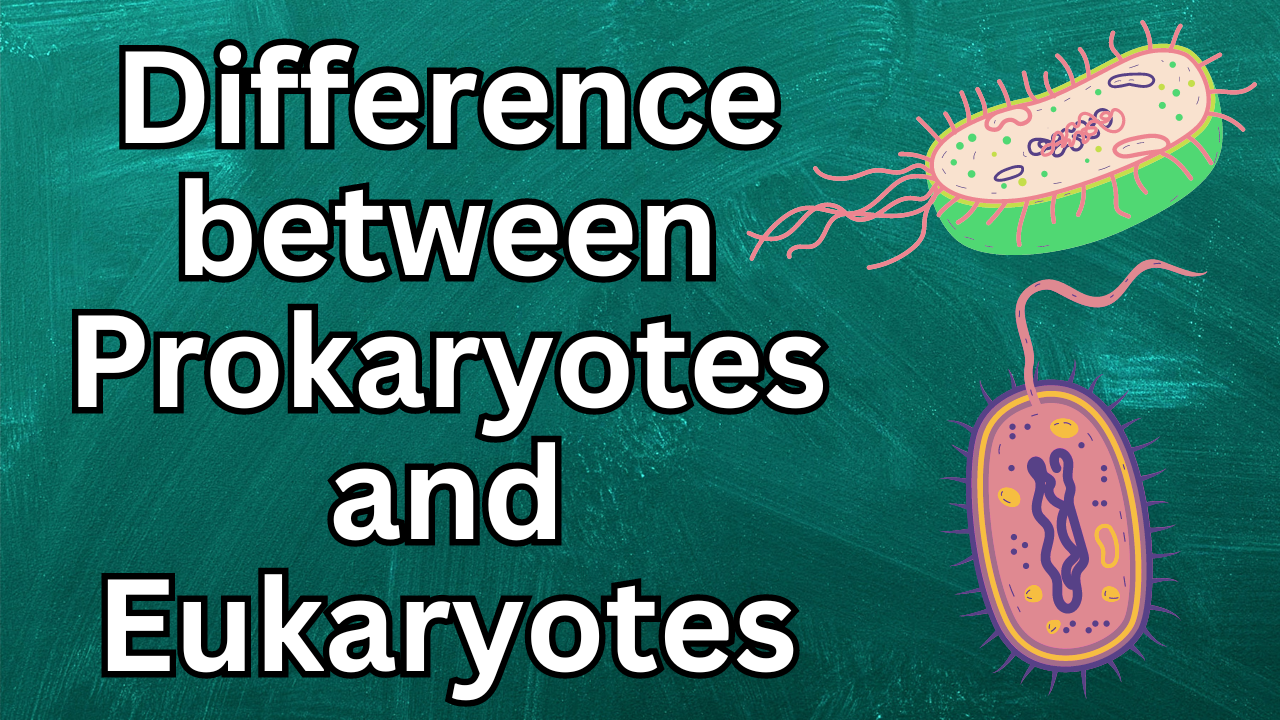What is the Difference between Prokaryotes and Eukaryotes?
The cell is the fundamental unit of life, yet not all cells are created equal. Broadly, all living organisms can be classified into two main groups based on the cellular structure: prokaryotes and eukaryotes. Understanding the differences between these two types of cells is crucial to grasp the complexity of life forms and their evolutionary significance. This post will provide a detailed exploration of the differences between prokaryotic and eukaryotic cells, examining their structure, functions, and biological roles.
What Are Prokaryotes?
Definition
- Prokaryotes are single-celled organisms that lack a membrane-bound nucleus and other organelles.
- They represent the most primitive forms of life on Earth, dating back approximately 3.5 billion years.
Examples
- Bacteria (e.g., Escherichia coli, Staphylococcus aureus)
- Archaea (e.g., Methanogens, Halophiles)
Characteristics of Prokaryotes
- Unicellular: Mostly single-celled organisms, though some (e.g., cyanobacteria) can form colonies.
- Lack of Membrane-Bound Organelles: No distinct nucleus or other organelles such as mitochondria or the endoplasmic reticulum.
- Small Size: Typically between 0.1 and 5 micrometers in size.
- Binary Fission: Reproduce asexually by splitting into two identical cells.
What Are Eukaryotes?
Definition
- Eukaryotes are organisms whose cells contain a membrane-bound nucleus and various specialized organelles.
- These organisms can be unicellular or multicellular and are more complex than prokaryotes.
Examples
- Animals (e.g., humans, cats, birds)
- Plants (e.g., trees, flowers)
- Fungi (e.g., yeast, mushrooms)
- Protists (e.g., Amoeba, Paramecium)
Characteristics of Eukaryotes
- Unicellular or Multicellular: Can exist as single-celled organisms (e.g., yeast) or as part of multicellular organisms (e.g., humans).
- Membrane-Bound Organelles: Contains specialized organelles like the nucleus, mitochondria, Golgi apparatus, etc.
- Larger Size: Usually between 10 and 100 micrometers in size.
- Mitosis and Meiosis: Reproduce via mitosis (for somatic cells) or meiosis (for gametes).
Major Differences Between Prokaryotes and Eukaryotes
1. Size
- Prokaryotes: Typically smaller, ranging from 0.1 to 5 micrometers in diameter.
- Eukaryotes: Generally larger, with sizes ranging from 10 to 100 micrometers.
2. Cell Structure and Complexity
- Prokaryotes:
- Lack internal compartments.
- No membrane-bound organelles like mitochondria, chloroplasts, or the nucleus.
- Cell structure is simple.
- Eukaryotes:
- Contain complex internal compartments.
- Have numerous membrane-bound organelles like the nucleus, Golgi apparatus, and lysosomes.
3. Nucleus
- Prokaryotes:
- Do not have a true nucleus.
- Genetic material (DNA) is found in a region called the nucleoid, which is not enclosed by a membrane.
- Eukaryotes:
- Possess a true nucleus.
- The nucleus is enclosed by a double membrane called the nuclear envelope, housing the cell’s genetic material.
4. Genetic Material (DNA)
- Prokaryotes:
- Contain a single, circular DNA molecule.
- DNA is often accompanied by small, additional rings of DNA called plasmids, which may carry genes for antibiotic resistance.
- Eukaryotes:
- DNA is organized into multiple linear chromosomes.
- Chromosomes are found within the nucleus and are complexed with histone proteins.
5. Cell Division
- Prokaryotes:
- Reproduce through binary fission, a simple process where the cell splits into two identical cells.
- No mitosis or meiosis is involved.
- Eukaryotes:
- Undergo cell division through mitosis (for somatic cell division) and meiosis (for sexual reproduction).
- Mitosis ensures each daughter cell receives an exact copy of the parent cell’s DNA, while meiosis leads to the production of gametes with half the number of chromosomes.
6. Ribosomes
- Prokaryotes:
- Contain smaller ribosomes (70S).
- Ribosomes are scattered freely in the cytoplasm.
- Eukaryotes:
- Have larger ribosomes (80S).
- Ribosomes can either be free-floating in the cytoplasm or attached to the endoplasmic reticulum (rough ER).
7. Cell Wall
- Prokaryotes:
- Most have a cell wall composed of peptidoglycan (in bacteria) or other polymers (in archaea).
- The cell wall provides shape and protection.
- Eukaryotes:
- Only plants, fungi, and some protists have a cell wall.
- The plant cell wall is made of cellulose, while fungal cell walls are composed of chitin.
8. Respiration and Energy Production
- Prokaryotes:
- Lack specialized structures for respiration.
- Cellular respiration occurs across the plasma membrane.
- Eukaryotes:
- Have specialized organelles like mitochondria where cellular respiration takes place.
- Plants have chloroplasts for photosynthesis.
9. Mode of Reproduction
- Prokaryotes:
- Reproduce asexually through binary fission.
- Genetic diversity arises through horizontal gene transfer mechanisms like transformation, transduction, and conjugation.
- Eukaryotes:
- Can reproduce both sexually (through meiosis and fertilization) and asexually (through mitosis).
- Sexual reproduction increases genetic diversity.
10. Cytoskeleton
- Prokaryotes:
- Lack a well-defined cytoskeleton.
- Simple protein filaments provide limited structural support.
- Eukaryotes:
- Possess a complex cytoskeleton made of microfilaments, intermediate filaments, and microtubules.
- The cytoskeleton provides shape, support, and facilitates intracellular transport.
Similarities Between Prokaryotes and Eukaryotes
Despite their differences, prokaryotes and eukaryotes share several key features:
- Genetic Material: Both types of cells use DNA as their genetic blueprint.
- Cell Membrane: Both have a plasma membrane that regulates the entry and exit of substances.
- Ribosomes: Both have ribosomes for protein synthesis, though eukaryotic ribosomes are larger.
- Cytoplasm: Both have cytoplasm, where metabolic activities occur.
- Metabolism: Both types of cells carry out similar metabolic processes, such as glycolysis.
Evolutionary Significance
Endosymbiotic Theory
The endosymbiotic theory is a widely accepted explanation for the evolution of eukaryotes from prokaryotic ancestors. According to this theory:
- Mitochondria and chloroplasts in eukaryotic cells were once free-living prokaryotes.
- These prokaryotic organisms were engulfed by larger primitive eukaryotic cells and established a symbiotic relationship.
- Over time, the engulfed prokaryotes became integral parts of the eukaryotic cell, leading to the development of complex life forms.
Evidence for this theory includes:
- Mitochondria and chloroplasts have their own DNA, which is similar to the circular DNA of prokaryotes.
- These organelles replicate independently of the cell and through a process similar to binary fission.
Importance of Prokaryotes and Eukaryotes in Biology
Prokaryotes
- Ecological Roles: Play essential roles in nutrient cycling, decomposition, and nitrogen fixation.
- Biotechnological Applications: Used in industries for fermentation, bioremediation, and production of antibiotics.
- Medical Significance: Some prokaryotes are pathogens causing diseases, while others are beneficial and part of the normal human microbiota.
Eukaryotes
- Diversity of Life: Eukaryotes make up the vast majority of the Earth’s biodiversity, including all plants, animals, and fungi.
- Organismal Complexity: The presence of specialized organelles allows eukaryotes to carry out complex cellular processes, leading to the development of multicellular organisms with specialized tissues and organs.
The distinction between prokaryotes and eukaryotes marks a fundamental division in the tree of life. While prokaryotes represent the simpler, ancient life forms, eukaryotes are the building blocks of more complex organisms. By understanding the differences and similarities between these two cell types, we gain a better appreciation of life’s evolutionary history and the diversity of biological functions across organisms.
MORE : A Brief Guide to Cell Structure and Function
<<<<<<<<<<<<JOIN US>>>>>>>>>>>>>>>>
| Subscribe our PHARMACY INDIA YouTube Channel for more Pharma Updates | Click Here |
| Follow us on Instagram | Click Here |
| Download PHARMACY INDIA MOBILE APP from Google Play Store | Click Here |
| Follow us on LinkedIn | Click Here |






